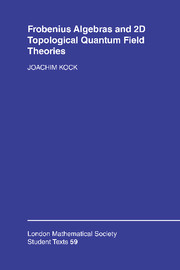Introduction
Published online by Cambridge University Press: 19 January 2010
Summary
In this introduction we briefly explain the words of the title of these notes, give a sketch of what we are going to do with these notions, and outline the viewpoint we will take in order to understand the structures. In the course of this introduction a lot of other words will be used which are probably no more familiar than those they are meant to explain – but don't worry: in the main text, all these words are properly defined and carefully explained …
Frobenius algebras. A Frobenius algebra is a finite-dimensional algebra equipped with a nondegenerate bilinear form compatible with multiplication. (Chapter 2 is all about Frobenius algebras.) Examples are matrix rings, group rings, the ring of characters of a representation, and Artinian Gorenstein rings (which in turn include cohomology rings, local rings of isolated hypersurface singularities …)
In algebra and representation theory such algebras have been studied for a century, along with various related notions – see Curtis and Reiner [15].
Frobenius structures. During the past decade, Frobenius algebras have shown up in a variety of topological contexts, in theoretical physics and in computer science. In physics, the main scenery for Frobenius algebras is that of topological quantum field theory (TQFT), which in its axiomatisation amounts to a precise mathematical theory. In computer science, Frobenius algebras arise in the study of flowcharts, proof nets, circuit diagrams …
In any case, the reason Frobenius algebras show up is that this is essentially a topological structure: it turns out that the axioms for a Frobenius algebra can be given completely in terms of graphs – or as we shall do, in terms of topological surfaces.
- Type
- Chapter
- Information
- Publisher: Cambridge University PressPrint publication year: 2003

